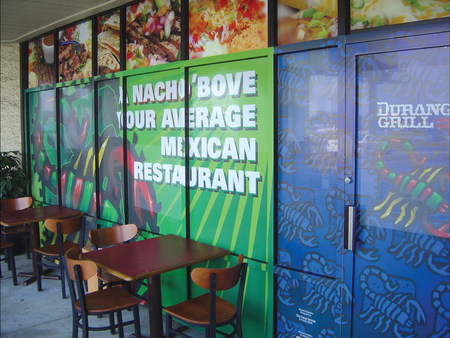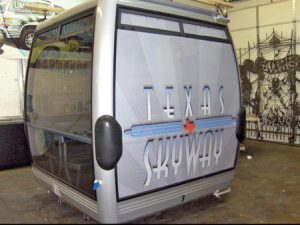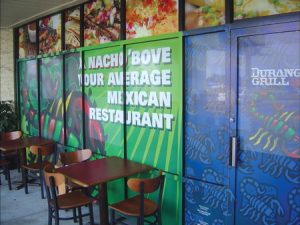Perforated window films serve increasingly diverse applications, and the variety of films with differing film-to-hole ratios has multiplied. These films, still used for vehicle and storefront-window graphics, now fulfill full-scale building wraps, POP and tradeshow-graphic needs.
Immensely popular out-of-home advertising outlets, vehicle wraps and window graphics are extremely cost effective and offer graphic impact that catches a consumer’s eye. Advertisers can achieve multiple and longer-lasting impressions compared to most other media.
Perforated films’ increased vehicle-wrap use has drawn more scrutiny from government officials. Regulations regarding the use of perforated films on public-transit and personal vehicles differ by state and locale. Films with an equal film-to-hole ratio and 2mm holes typically meet federal, state and local regulations. Because these regulations vary, installers must determine, prior to use, the material’s suitability for their specific purposes, including compliance with federal, state and local regulations.
Before you begin
Window perforation films are available in cast and calendered versions, and each has advantages. Calendered films are easy to install and conform well to flat and simple curves, whereas cast films offer better conformability to a wider substrate range. Most window films are printable with solvent, eco-solvent, UV-curable and screenprinting inks and printers.
Consider the application and the graphic’s expected lifetime when choosing a perforated window film. Film durability ranges from one to three years – follow manufacturer durability and application guidelines closely.
Advertisement
There are also a variety of film-to-hole ratios and hole sizes to consider for each type of application. Films with larger, 2mm-wide holes provide more light transmission, less opacity and broader application types that comply with federal, state and local regulations. Some states have begun mandating larger hole sizes to allow law-enforcement officials clear visibility into vehicles during traffic stops.
Retail settings may require a higher quality image and look – a window perforation film with a greater printable surface area would be more appropriate, and a film with a higher film-to-hole ratio and smaller holes would be the right choice.
Design
When designing bus, vehicle or storefront-window graphics, designers must realize perforated window film doesn’t have an uninterrupted film surface. To accommodate for this lesser film coverage, use darker, more vivid color schemes. Lighter colors will produce a washed-out graphic because of the lesser amount of film present on the surface.
Installers must know and understand local vehicle-graphic regulations. For instance, a bus window that doubles as an emergency exit must remain operational once the graphics are in place. Installers must open all the emergency-exit windows to verify safe usage prior to applying the perforated window film. The installer can determine exactly where the graphics must be trimmed to ensure the exit’s functionality.
Avery Graphics recommends that vinyl not be applied to any malfunctioning, emergency-exit window – problems should be reported to maintenance personnel. Failure to do so could violate federal laws and subject installers to substantial fines.
Advertisement
Prepping your surface
To ensure a successful window-perforation-film application, prepare your surface completely and properly. Clean windows with isopropyl alcohol (IPA) and then check them to make sure no IPA residue remains. Follow all of the solvent manufacturers’ warnings and safety instructions.
Avoid the wet-application method during installation. Water or application fluid not properly drained from underneath the film can remain between the substrate and the decal, which will trigger adhesion failure.
Application
Once you’ve printed your graphic, measure twice and cut once. This tried-and-true advice minimizes wasted time, money and material. Measure the decal to make sure it fits into the window with a clearance around any rubber gaskets or seals. The vinyl should never touch or overlay any window moldings. Adhesion loss can occur when the vinyl overlaps moldings, which causes material failure.
Trimming should occur prior to application; cutting film on a window may permanently scratch the window and leave the service provider vulnerable to a damage claim.
Use low-tack tape, such as masking tape, at the top of the image to position it into place on the window while the liner is still attached. You can test drive the position without committing to it. Once you’ve determined the final position, flip the graphic up using the tape as a hinge.
Start removing the liner from the top down. Flip the graphic back down and apply squeegee pressure on the film, which creates adhesive contact to the window. Remove the liner as you go. Start the squeegee action in the middle of the image and work from one side to the other.
Advertisement
Continue this process from the top of your decal down, using overlapping strokes. If necessary, the graphic can be adjusted carefully to realign the material or take out wrinkles. Re-squeegee the material after repositioning. If panels meet edge-to-edge in the window, trim the edges carefully to form a butt seam. Don’t overlap seams or edges.
Seal all exposed edges and seams of exterior window graphics with an edge sealer. This prevents water and contaminants from getting under the film and obstructing the view or damaging the adhesive. Use a ¼-in. (6mm) brush to apply sealer to increase control and allow neater application.
Final touches
To enhance the printed image, protect it and increase its lifespan, use a digital overlaminate. I recommend either a clear, polyester, perforated overlaminate or a clear, conformable, cast overlaminate. The overlaminate should be as clear as possible and provide a tough, durable, solvent- and abrasive-resistant surface.
Case in point
An innovative, new project with window perforation film was installed on each gondola of the Texas Skyway®, an aerial ride that premiered at the 2007 Texas State Fair. Skinz Wraps (Dallas) wrapped each of the ride’s gondolas with an art-deco graphic printed on perforated window film. The wrapped gondolas provided a branded aerial visual at the fair without impeding riders’ views of the fair’s happenings below.


 Tip Sheet3 days ago
Tip Sheet3 days ago
 Business Management1 week ago
Business Management1 week ago
 Women in Signs2 weeks ago
Women in Signs2 weeks ago
 Real Deal4 days ago
Real Deal4 days ago
 Editor's Note1 week ago
Editor's Note1 week ago
 Maggie Harlow2 weeks ago
Maggie Harlow2 weeks ago
 Line Time2 weeks ago
Line Time2 weeks ago
 Product Buying + Technology1 week ago
Product Buying + Technology1 week ago



















